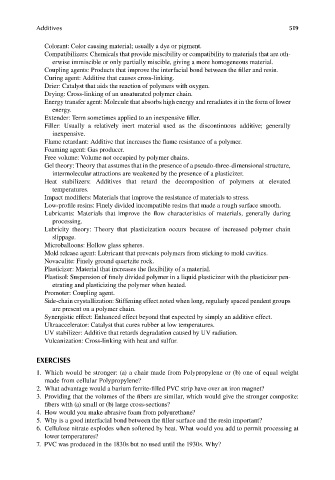Page 556 - Carrahers_Polymer_Chemistry,_Eighth_Edition
P. 556
Additives 519
Colorant: Color causing material; usually a dye or pigment.
Compatibilizers: Chemicals that provide miscibility or compatibility to materials that are oth-
erwise immiscible or only partially miscible, giving a more homogeneous material.
Coupling agents: Products that improve the interfacial bond between the filler and resin.
Curing agent: Additive that causes cross-linking.
Drier: Catalyst that aids the reaction of polymers with oxygen.
Drying: Cross-linking of an unsaturated polymer chain.
Energy transfer agent: Molecule that absorbs high energy and reradiates it in the form of lower
energy.
Extender: Term sometimes applied to an inexpensive fi ller.
Filler: Usually a relatively inert material used as the discontinuous additive; generally
inexpensive.
Flame retardant: Additive that increases the flame resistance of a polymer.
Foaming agent: Gas producer.
Free volume: Volume not occupied by polymer chains.
Gel theory: Theory that assumes that in the presence of a pseudo-three-dimensional structure,
intermolecular attractions are weakened by the presence of a plasticizer.
Heat stabilizers: Additives that retard the decomposition of polymers at elevated
temperatures.
Impact modifiers: Materials that improve the resistance of materials to stress.
Low-profile resins: Finely divided incompatible resins that made a rough surface smooth.
Lubricants: Materials that improve the flow characteristics of materials, generally during
processing.
Lubricity theory: Theory that plasticization occurs because of increased polymer chain
slippage.
Microballoons: Hollow glass spheres.
Mold release agent: Lubricant that prevents polymers from sticking to mold cavities.
Novaculite: Finely ground quartzite rock.
Plasticizer: Material that increases the flexibility of a material.
Plastisol: Suspension of finely divided polymer in a liquid plasticizer with the plasticizer pen-
etrating and plasticizing the polymer when heated.
Promoter: Coupling agent.
Side-chain crystallization: Stiffening effect noted when long, regularly spaced pendent groups
are present on a polymer chain.
Synergistic effect: Enhanced effect beyond that expected by simply an additive effect.
Ultraaccelerator: Catalyst that cures rubber at low temperatures.
UV stabilizer: Additive that retards degradation caused by UV radiation.
Vulcanization: Cross-linking with heat and sulfur.
EXERCISES
1. Which would be stronger: (a) a chair made from Polypropylene or (b) one of equal weight
made from cellular Polypropylene?
2. What advantage would a barium ferrite-filled PVC strip have over an iron magnet?
3. Providing that the volumes of the fibers are similar, which would give the stronger composite:
fibers with (a) small or (b) large cross-sections?
4. How would you make abrasive foam from polyurethane?
5. Why is a good interfacial bond between the filler surface and the resin important?
6. Cellulose nitrate explodes when softened by heat. What would you add to permit processing at
lower temperatures?
7. PVC was produced in the 1830s but no used until the 1930s. Why?
9/14/2010 3:42:50 PM
K10478.indb 519 9/14/2010 3:42:50 PM
K10478.indb 519

